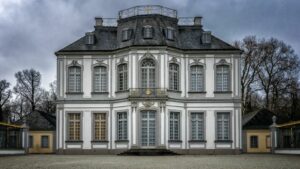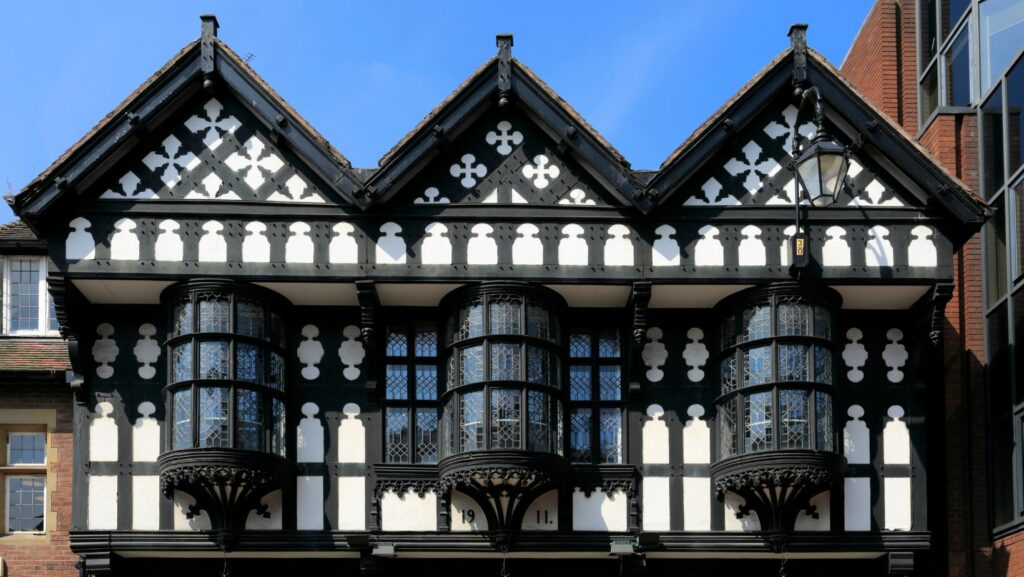From the medieval castles dotting the countryside to the futuristic skyscrapers piercing London’s skyline, English architectural styles tell a rich and varied tale of the nation’s history. Each structure, whether it’s an ancient cathedral or a modern office building, serves as a testament to the time when it was created, reflecting the social, political, and cultural climate of that era.
In this article, we’ll delve into the fascinating world of English architecture. We’ll explore the distinctive characteristics of various styles, tracing their evolution from the Anglo-Saxon period right up to the present day. So, whether you’re an architecture enthusiast or simply curious about the buildings you see every day, this journey through England’s architectural past is sure to captivate your interest.
English Architectural Styles
 The passage through time showcases distinctive English architectural styles, deeply entrenched in the social fabric. Anglo-Saxon architecture, initiating the historical timeline, stood firm with its simplistic design, primarily composed of timber and earthwork. The period marked churches like All Saints Church, Brixworth, as exemplary models of this era.
The passage through time showcases distinctive English architectural styles, deeply entrenched in the social fabric. Anglo-Saxon architecture, initiating the historical timeline, stood firm with its simplistic design, primarily composed of timber and earthwork. The period marked churches like All Saints Church, Brixworth, as exemplary models of this era.
Following swiftly, Normans introduced more robust Romanesque architecture. The durability and strength they offered remains evident in constructions like Durham Cathedral. By the 12th century, Gothic architecture took dominance, exhibiting sweeping vaults and pointed arches. The Canterbury Cathedral stands as a testament to this period’s aesthetic zenith.
Modern architecture, the current period, encompasses more than a century of variations, with Foster’s Gherkin and Rogers’ Lloyds Building showcasing the rise of technological innovation. As such, English architecture’s evolution functions as a mirror to the dynamic tales spun by history.
Defining Features of English Architecture
 From Anglo-Saxon roots to modern marvels, English architecture exemplifies an intricate tapestry of designs. Each era has distinct features. Anglo-Saxon structures, like All Saints Church, Brixworth, wore simplicity as a hallmark, with stripped down, modest, functional designs. Romanesque architecture, exemplified by Durham Cathedral, boasted robust, round-arched structures and massive proportions. The Gothic period, marked by the Canterbury Cathedral, favored pointed arches, ribbed vaults, and flying buttresses; it’s a style rendered grand, vertical, and light-filled. The English Renaissance, capturing Hampton Court Palace’s classic symmetry, brought a revival of ancient Greek and Roman forms. Georgian and Victorian eras, as shown in St. Pancras railway station, portrayed elegance and ornate details, often with a romantic nod to medieval aesthetics. Modern English architecture, like Foster’s Gherkin and Rogers’ Lloyds Building, embraces bold, innovative designs and cutting-edge technology. Such an overview of defining features captures the dynamic, evolving narrative of English architecture.
From Anglo-Saxon roots to modern marvels, English architecture exemplifies an intricate tapestry of designs. Each era has distinct features. Anglo-Saxon structures, like All Saints Church, Brixworth, wore simplicity as a hallmark, with stripped down, modest, functional designs. Romanesque architecture, exemplified by Durham Cathedral, boasted robust, round-arched structures and massive proportions. The Gothic period, marked by the Canterbury Cathedral, favored pointed arches, ribbed vaults, and flying buttresses; it’s a style rendered grand, vertical, and light-filled. The English Renaissance, capturing Hampton Court Palace’s classic symmetry, brought a revival of ancient Greek and Roman forms. Georgian and Victorian eras, as shown in St. Pancras railway station, portrayed elegance and ornate details, often with a romantic nod to medieval aesthetics. Modern English architecture, like Foster’s Gherkin and Rogers’ Lloyds Building, embraces bold, innovative designs and cutting-edge technology. Such an overview of defining features captures the dynamic, evolving narrative of English architecture.
Iconic Examples of English Architectural Styles
 All Saints Church in Brixworth stands as a prime example of Anglo-Saxon architecture, its simplicity a testament to earlier times. It gave way to Durham Cathedral’s Romanesque robustness, reflecting a change in design and society. Evolution continued into the 12th century when Gothic architecture grabbed the spotlight, Canterbury Cathedral serving as an iconic model. Then, a shift in aesthetics, the English Renaissance brought classic symmetry to structures like Hampton Court Palace. Innovation didn’t stop there, though. St. Pancras railway station exhibits exquisite Georgian and Victorian styles, inspired by the Industrial Revolution’s societal impacts. This journey ends with modern architecture exemplified by Foster’s Gherkin and Rogers’ Lloyds Building.
All Saints Church in Brixworth stands as a prime example of Anglo-Saxon architecture, its simplicity a testament to earlier times. It gave way to Durham Cathedral’s Romanesque robustness, reflecting a change in design and society. Evolution continued into the 12th century when Gothic architecture grabbed the spotlight, Canterbury Cathedral serving as an iconic model. Then, a shift in aesthetics, the English Renaissance brought classic symmetry to structures like Hampton Court Palace. Innovation didn’t stop there, though. St. Pancras railway station exhibits exquisite Georgian and Victorian styles, inspired by the Industrial Revolution’s societal impacts. This journey ends with modern architecture exemplified by Foster’s Gherkin and Rogers’ Lloyds Building.
The Fusion of Old and New in Contemporary English Architecture
From the humble beginnings of Anglo-Saxon structures to the grandeur of Gothic design, the journey of English architectural styles has been a fascinating one. It’s a tale that speaks of the nation’s evolving tastes and technological advancements. The robust Romanesque style of Durham Cathedral, the classical symmetry of English Renaissance in Hampton Court Palace, and the ornate details of Georgian and Victorian styles at St. Pancras railway station all tell a story of their own. Today, the narrative continues, with modern marvels like Foster’s Gherkin and Rogers’ Lloyds Building adding fresh chapters to this ongoing architectural saga. This fusion of the past and the present is what makes English architecture unique, dynamic, and ever-evolving.

